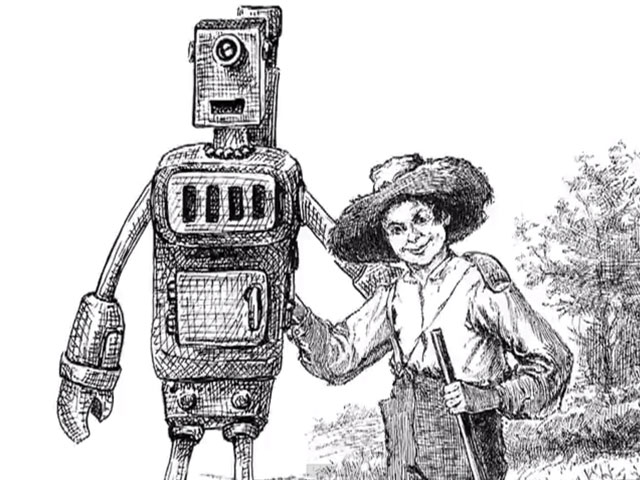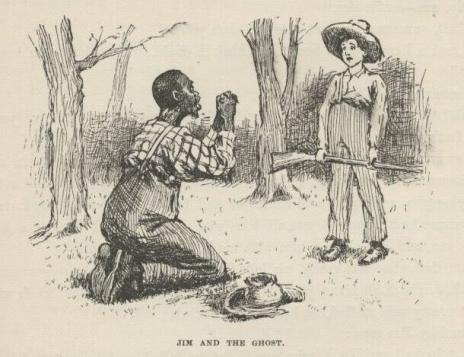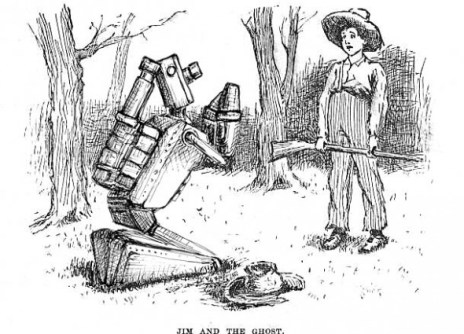Mark Twain’s novel, Adventures of Huckleberry Finn is what most would call a “classic.” Published in 1884 with illustrations from E.W. Kemble, Huckleberry Finn was not widely praised but rather criticized for its vernacular and what was seen as a crude writing style all around. It had its troubles at first but it wasn’t until the 20th century that it garnered a large amount of criticism for what people considered its racial stereotypes. Though it’s banned in certain schools (even to this day), the novel is often names as one of America’s Greatest novels. But what if it had…robots?
That’s where creators Gabriel Diani and Etta Devine come in. Much like Seth Grahame-Smith’s Pride and Prejudice and Zombies, Diani and Devine added a modern term into a classic piece of fiction. But Diani and Devine had a very particular goal. They didn’t just want to add zombies to Huckleberry Finn and create an alternate world, they wanted to make a point of it. So they replaced every instance of the “n-word” or “slave” with “robot,” to rather interesting effect. Hence, Adventures of Huckleberry Finn Robotic Edition was born. Read on for our interview with Diani and Devine where they discuss their approach to the project, challenges, and why censorship is a bad idea.
The Mary Sue: First thing’s first. Why Huckleberry Finn and why robots?
Gabriel Diani: Well, last year a company called NewSouth Books decided to publish a version of Huck Finn that replaced the “n-word” with “slave” to try and keep it from being censored in schools and libraries.
Etta Devine: We thought that censoring something to keep it from being censored was ridiculous. Should we take the violence out of Lord of the Flies or give The Diary of Anne Frank a happily ever after?
GD: Twain’s use of the word is deliberate to show Huck’s journey from accepting the racist social norms of the time to rejecting them and accepting that he’d rather “go to hell” than let his friend be sold back into slavery. So we decided to replace the “n-word” with “robot” to make Twain’s point that the difference between “the almost right word and the right word” is “the difference between the lightning bug and the lightning.”
ED: Nothing against lightning bugs.
GD: And so we chose robot because if someone were to really take this idea of making the book more palatable seriously why not remove any mention of race altogether?
ED: Using “robot” is actually a good analogy. It makes much more sense than slave. Robot is from the Slav word for forced labor. If you look at robots in literature they are usually metaphors for the oppressed. What are C3-PO and R2-D2 but Luke’s slaves?
GD: “Master Luke.”
TMS: When you first had the idea, did you think you’d take it this far or was it just a passing thought?
ED: It was a passing thought. Gabe tweeted that he was doing his own version of the book and that correcting all the grammar was taking forever. He then followed up with saying he was replacing the “n-word” with “robot.”
GD: Etta then had the crazy idea to actually do it. We had just been involved with a friend’s successful Kickstarter project and we realized that there might be some people out there foolish enough to help us ruin classic literature.
TMS: Tell us a bit about the actual process of going through and changing the text of such a classic work and publishing an altered version. Was it difficult? Was there anything you wanted to avoid? Any trouble spots?
ED: We read through the book several times to identify anything that mentions Jim’s humanity or the existence of race. So Jim’s eye became an optical lens, his food became coal or kindling, and things like Spanish Moss became Synthetic Moss. We wouldn’t want to offend any Spaniards either.
GD: There were definitely trouble spots though. Jim gets bitten by a snake and is sick for a couple of days and there’s a plot point involving a pie towards the end.
ED: It’s amazing how many human-y things a human in a book does.
TMS: What do you think it says about the original work that the racial terms and character could be replaced in such a way?
GD: That it is in the public domain.
ED: You can ruin anything over 100 years old this way.
GD: Other than that, it’s just really a happy coincidence for us that it worked so well from a satiric standpoint.
TMS: It’s not just the text of course, there’s also a series of illustrations depicting the story in the style of the original artist, E.W. Kemble. Was that a must?
GD: We absolutely wanted to do all the illustrations but the amount of time and money involved in doing that seemed prohibitive at first.
ED: The success of the Kickstarter campaign–
GD: We raised $30,000 to fund the project.
ED: –provided the opportunity to do them all. There are 120 original illustrations by E.W. Kemble in the book. Forty of those include Jim or other characters who were changed into robots. My mom actually altered the illustrations for us. She did an amazing job. I know there are Child Labor Laws in the US but there should probably be some Parent Labor Laws too.
TMS: Who do you think the book will appeal to the most?
ED: A friend of ours said, “This is something that smart people will give to other smart people.”
GD: So buy our book if you’re not dumb.
TMS: If someone hasn’t read the original work, will they appreciate your altered version more you think, or less? And what about those who are very familiar with the original?
ED: Despite the fact that a lot of little things had to change the work is 99.9% intact. I’d say that someone who’s never read the book could read ours and honestly say they’d read Huck Finn.
GD: I think Etta has Stockholm Syndrome. We’ve been living with this idea for so long that we’re actually starting to think it’s a good idea. Honestly, I think that the book works for anyone who understands what we’re doing. At the risk of sounding pretentious…
ED: Too late.
GD: ..this is kind of a multi-media art project. The fundraising video works in conjunction with the book, trailer, and introductory essay we wrote to create something that’s bigger than any individual piece of the puzzle.
ED: Ideally people should get out of it that Robots are awesome and censoring a classic book or any piece of art is a terrible idea.
GD: And that the book makes a great Christmas or birthday gift.
TMS: What about the potential for the book to be read in schools that previously banned the text?
GD: We’d love to send classroom sets to every school that has banned the book but if they’ve banned the book I don’t think they’d get the joke. Lots of our Kickstarter backers are teachers or Librarians who said they will be using the book as a teaching tool in the classroom though.
ED: When you teach Huck Finn you have to address the fact that it is very uncomfortable to say and read the offensive language. The Robotic Edition can be a useful tool to explain why the original book is so important. It also has robots in it.
TMS: Can you see this scenario working in any other creative work or was Huckleberry Finn a special case?
GD: If we were good business people we would probably come up with some kind of cynical way to create a whole robot series of books but Huck Finn really feels like a special case because of its history and subject matter.
ED: Also, we’re not good business people.
TMS: Is there anything else you’re working on that you’d like our readers to know about?
GD: We’re working on an audio book of Huck Finn that we’ll be releasing as a free podcast. Also, our feature film The Selling is coming out on DVD/VOD on August 21.
ED: It’s about a real estate agent trying to sell a haunted house. We also have a bunch of feature scripts in development, a web series we’d like to continue and a dog who likes to be walked EVERY DAY.
GD: He’s so selfish.
ED: We also just launched our new website www.DianiAndDevine.com where people can buy the book and our other Kickstarter incentives including a wonderful model of Robot Jim by Chad Meserve.
TMS: Thanks so much for chatting with us, guys!
Download a free sample of the book on their website. You can also learn more about it on their official Facebook page and take a look at another video they made to explain Adventures of Huckleberry Finn Robotic Edition.










Published: Apr 12, 2012 12:33 pm